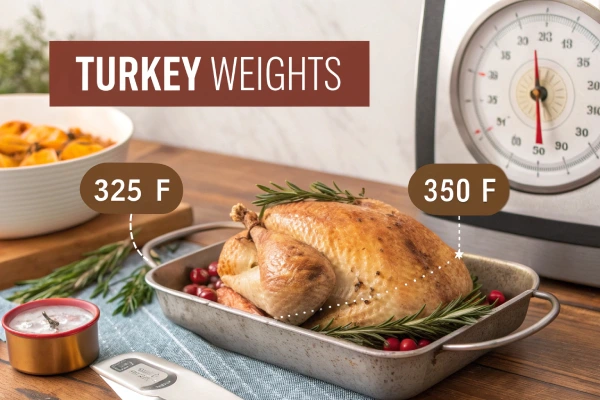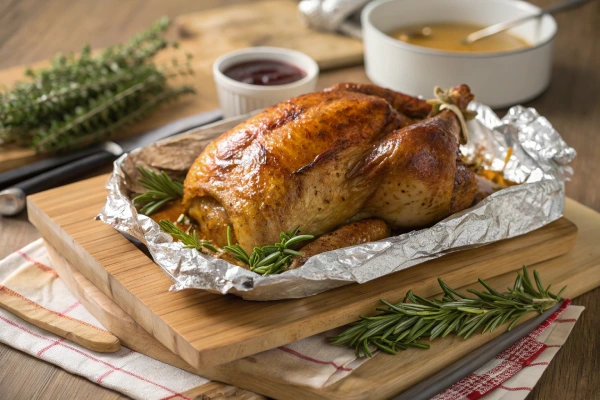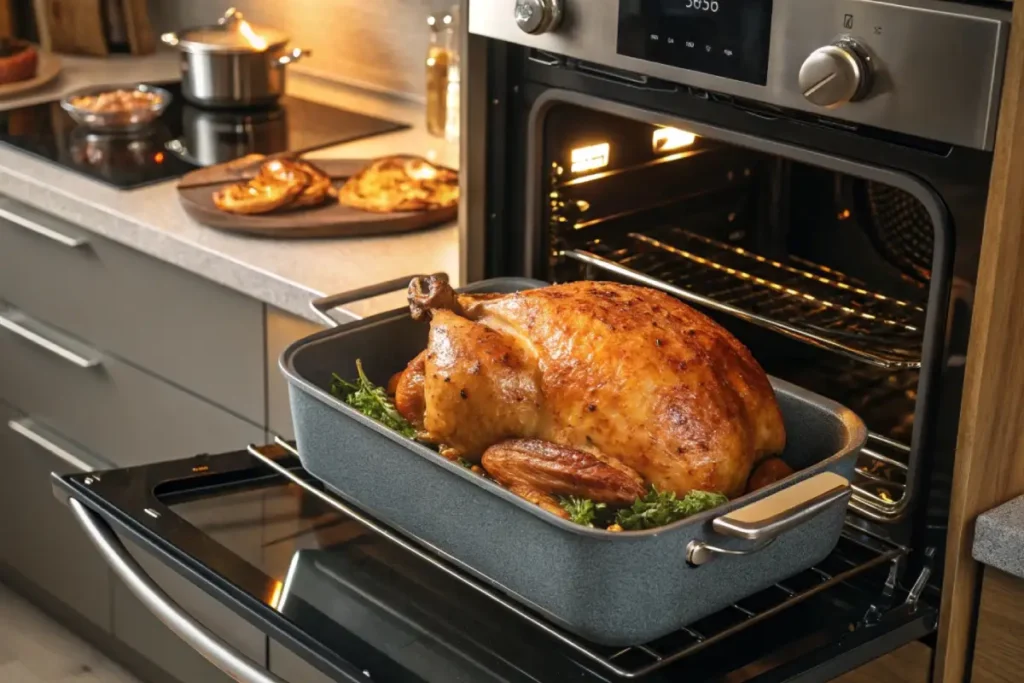Table Of Contents
Table of Contents
Should I Roast My Turkey at 325 or 350? The temperature of your oven is a crucial factor in cooking the perfect turkey. This question has puzzled home cooks for generations. The temperature you choose can significantly influence the turkey’s texture, flavor, and juiciness. Both temperatures have their advantages and disadvantages, and understanding the differences will help you make the right choice, whether you’re preparing a holiday feast or simply aiming for the perfect roast. Let’s explore each temperature and its pros and cons to help you decide which is best for your next turkey masterpiece.
Understanding Turkey Roasting Temperatures
Why Temperature Matters
The temperature at which you roast your turkey is crucial to its final flavor and texture. According to USDA guidelines on safe turkey preparation, both 325degF and 350degF an effective temperatures for roasting turkey. You may have wondered, “Should my turkey be roasted at 325 degrees or 350 degrees?” Understanding how temperatures affect the cooking process will help you to make an informed decision. The guidelines emphasize that the bird must be fully cooked but not overcooked or dry.
Common Techniques for Roasting Turkey
Consider the texture and flavor you want in your turkey when deciding on 325degF or 350degF. Slow roasting at 325degF keeps the meat moist while 350degF produces crispier skin. Consider incorporating the techniques in Tips for a Juicy and Flavorful Turkey to achieve a flavorful and juicy bird. Turkey is also a highly nutritious food. This article, Health Benefits of Turkey Meat discusses the rich protein and essential nutrients in turkey meat.
Differences between 325degF & 350degF

Variations in Cooking Time
- The turkey takes longer to cook at 325degF. It will take approximately 15-17 minutes for each pound.
- The time per pound is reduced to 13-15 minutes at 350degF. This makes it a faster option.
How temperature affects texture and moisture
- Roasting the turkey at 325degF low temperature helps to retain moisture and make it tender.
- The skin will be crispier at temperatures above 350degF, but you must monitor the temperature closely to prevent drying of the meat.
Benefits Of Roasting Turkey At 325degF
The Pros of Slow and Low Cooking
This method ensures that the entire bird is cooked evenly. This reduces the chance of overcooking outer layers and not getting the meat fully cooked.
How to Dry Meat Minimally and Get Tender Meat
Low heat helps to preserve the natural juices of the turkey, which keeps the meat tender and flavorful.
Benefits Of Roasting Turkey At 350degF
Cooking Times Are Faster
If you are short on time, a roast at 350degF is ideal. It’s perfect for small turkeys or when your oven needs to be used for several dishes.
Crispy skin without overcooking
The higher the temperature, the better it is for getting golden skin with a crispy texture. This improves both presentation and taste.
Considerations
Turkey Size & Weight
The size of the turkey is a major factor in determining what temperature to roast it at. A smaller turkey under 12 pounds can be cooked efficiently at 350 degrees F. The 325degF method is best for larger turkeys because it allows them to cook evenly and slowly. When cooking a large turkey, 325degF is often the best option to ensure an even cook.
Stuffed vs. Unstuffed Turkey
It’s best to cook a stuffed bird at a lower heat, such as 325degF. The added time required to cook the stuffing can be a challenge. The stuffing can be undercooked if the temperature is too high. This poses a safety hazard.
Oven performance and accuracy
Some ovens do not heat up evenly. Some ovens may have hot spots where food cooks faster, while others may have cooler zones. You may need to reduce the temperature if your oven is hot. This will prevent the turkey from being burned. Use an oven thermometer when determining the temperature of your oven.
Time Limits
Roasting at 350degF is a good option if you are in a rush or don’t have time. This reduced cooking time will help you get dinner on your table quicker.
How To Monitor Turkey Temperature When Cooking
The importance of a meat thermometer
A meat thermometer will ensure that the turkey is cooked to the correct internal temperature, which is 165 degrees Fahrenheit. Check out our recipe for Herb Butter Roasted Turkey: A Timeless Recipe to learn how you can improve the flavor and texture of your turkey. This resource offers tips on how to infuse your turkey with herbs and butter. It is a technique that works well with either roasting method.
How To Check For Proper Work
For an accurate reading, insert the thermometer in the thickest part of the breast or thigh. Avoid the bone.
Cooking times for various weights at 325degF

Guide to Small, Medium, and Large Turkeys
- 10-12 pounds: 3-4 hours
- 12-14 pounds: 4-4.5 hours
- 14-18 pounds: 4.5-5 hours
Cooking times for various weights at 350degF
Adjusting times for faster roasting
- 10-12 pounds: 2.5-3 hours
- 12-14 pounds: 3-3.5 hours
- 14-18 pounds: 3.5-4 hours
Tents and Foil Techniques
Preventing Overbrowning
The skin of the turkey will not brown too much if you cover it with foil during the roasting process.
How to Cook Food Juiciness
For the last 30 minutes, tent the turkey loosely using foil to seal in moisture.
How to Rest Your Turkey After Roasting

Why Rest is Important
The meat will become tender and more flavorful when you rest it.
How long to rest a turkey based on temperature
Rest the turkey for 20-30 minutes to seal in moisture.
Finalizing the Decision: 325degF or 350degF
Balance Time, Texture, and Flavor
- You can enjoy a slow-roasted, traditional turkey at 325degF that is tender and juicy.
- Choose 350degF to roast faster with crisper skin and more robust flavors.
How to Choose the Temperature
When deciding, consider the size of your turkey, the cooking time available, and the desired results.
Troubleshooting common turkey roasting issues
Uneven cooking
Inconsistencies in oven temperatures are the most likely cause of uneven cooking. Try rotating the bird halfway through the cooking process or use an oven thermometer for accurate temperature monitoring.
Dry Turkey Meat
Consider basting the turkey during the roasting procedure, especially if the temperature is set at 350degF. You can also cook the turkey with a cover to seal it in moisture.
Undercooked or Overcooked Turkey
The problem usually occurs when the temperature has been set too high or too low. Check the temperature of the turkey in several places to make sure it is fully cooked. Remember to adjust the temperature if necessary and that it is better to cook slowly and check it often.
FAQs About Should I Roast My Turkey at 325 or 350?
Is it better to bake a turkey at 325 or 350?
It depends on your priorities! Roasting at 325°F ensures even cooking and juicier meat, while 350°F speeds up the process but requires careful monitoring to avoid drying out the turkey.
Is it better to cook a roast at 325 or 350?
For roasts, 325°F is ideal for tender, evenly cooked meat. Higher temperatures like 350°F can work for smaller cuts but may risk uneven cooking or dryness.
Will turkey skin crisp at 325 degrees?
Yes, but it may take longer. For crispier skin, start at 325°F and increase the temperature to 400°F for the last 15-20 minutes of cooking.
How long to cook a 7.5 lb turkey at 325 degrees?
A 7.5 lb turkey typically takes about 2.5 to 3 hours at 325°F. Use a meat thermometer to ensure the internal temperature reaches 165°F in the thickest part of the thigh.
Conclusion
The right temperature for cooking turkey can mean the difference between a bird that is dry and overcooked and one that is moist and delicious. It’s important to take into account your individual needs when deciding between 325degF or 350degF. You can roast a smaller bird or a bigger one. The key is to monitor the temperature inside and use a thermometer. Do not be afraid to experiment with both methods. See which works best for you and your family.
Looking for more tasty recipes and cooking inspiration? Connect with us on Facebook at Dashtasty and become part of our foodie family.



